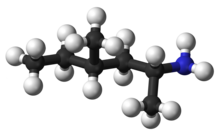Methylhexaneamine
 |
|
 |
|
| Clinical data | |
|---|---|
| Routes of administration |
Nasal spray, oral |
| ATC code |
|
| Pharmacokinetic data | |
| Biological half-life | ~8.5 hours |
| Identifiers | |
|
|
| Synonyms | Methylhexaneamine, methylhexamine, geranamine, geranium extract, geranium oil, 2-amino-4-methylhexane, dimethylamylamine, DMAA, 1,3-dimethylamylamine, 1,3-DMAA, 1,3-dimethylpentylamine, 4-methyl-2-hexanamine, 4-methyl-2-hexylamine |
| CAS Number | |
| PubChem CID | |
| ChemSpider | |
| UNII | |
| ECHA InfoCard | 100.002.997 |
| Chemical and physical data | |
| Formula | C7H17N |
| Molar mass | 115.21658 g/mol |
| 3D model (Jmol) | |
|
|
|
|
| |
|
Methylhexanamine (trade names Forthane, Geranamine) or methylhexamine, commonly known as 1,3-dimethylamylamine (1,3-DMAA) or simply dimethylamylamine (DMAA), is an indirect sympathomimetic drug invented and developed by Eli Lilly and Company and marketed as an inhaled nasal decongestant from 1944 until it was voluntarily withdrawn from the market in 1983.
Since 2006 methylhexanamine has been sold extensively under many names as a stimulant or energy-boosting dietary supplement under the claim that it is similar to certain compounds found in geraniums, but its safety has been questioned as a number of adverse events and at least five deaths have been associated with methylhexanamine-containing supplements. It is banned by many sports authorities and governmental agencies.
In April 1944, Eli Lilly and Company introduced methylhexanamine under the brand name Forthane as an inhaled nasal decongestant; Lilly voluntarily withdrew methylhexanamine from the market in 1983. The compound is an aliphatic amine; the pharmaceutical industry had a strong interest in compounds in this class as nasal decongestants in the early 20th century, which led to methylhexanamine and four other similar compounds being brought to market for that use: tuaminoheptane, octin, oenethyl, and propylhexedrine; octin and oenethyl were eventually approved for use in keeping blood pressure sufficiently high for patients under anesthesia.
Patrick Arnold reintroduced methylhexanamine in 2006 as a dietary supplement, after the final ban of ephedrine in the United States in 2005. Arnold introduced it under the trademarked name Geranamine, a name held by his company, Proviant Technologies. A large number of supplements focusing on fat loss and workout energy (thermogenic or general-purpose stimulants) used the ingredient in concert with other substances such as caffeine, a combination similar to the combination of ephedrine and caffeine.
...
Wikipedia
